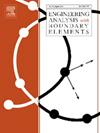A level set-based topology optimization method for the design of finite phononic crystals
IF 4.1
2区 工程技术
Q1 ENGINEERING, MULTIDISCIPLINARY
Engineering Analysis with Boundary Elements
Pub Date : 2025-10-06
DOI:10.1016/j.enganabound.2025.106492
引用次数: 0
Abstract
This study presents a level set-based topology optimization method for finite phononic crystals. To minimize the wave transmission on the boundary of the output domain, the adjoint method is employed to derive the topological derivatives. The boundary element method is then utilized to efficiently solve both the original and adjoint elastic dynamic problems, allowing for effective handling of boundary conditions. The boundaries of the material region are described by the zero-contour line of the level set function. Within a finite periodic unit, the optimization is performed, and numerical examples are provided for different frequency ranges. The results show that the proposed method can significantly reduce the wave transmission at a specific frequency and exhibit good vibration isolation performance. The vibration isolation effect can be increased by increasing the number of optimized layers, but the attenuation band gap is not necessarily enlarged. A parameter is also investigated for its influence on structural complexity, demonstrating that appropriate adjustment can balance geometric complexity and engineering feasibility. This method provides an effective means for the optimal design of phononic crystals and has the potential to be extended to a wider range of elastic metamaterial design problems.
基于水平集的有限声子晶体拓扑优化设计方法
提出了一种基于水平集的有限声子晶体拓扑优化方法。为了使输出域边界上的波传播最小,采用伴随法推导拓扑导数。然后利用边界元方法有效地求解原始和伴随弹性动力问题,从而有效地处理边界条件。材料区域的边界由水平集函数的零等高线描述。在有限周期单元内进行了优化,并给出了不同频率范围内的数值算例。结果表明,该方法能显著降低特定频率下的波透射率,并具有良好的隔振性能。通过增加优化层数可以提高隔振效果,但衰减带隙不一定会增大。研究了一个参数对结构复杂性的影响,表明适当的调整可以平衡几何复杂性和工程可行性。该方法为声子晶体的优化设计提供了一种有效的手段,并有可能推广到更广泛的弹性超材料设计问题。
本文章由计算机程序翻译,如有差异,请以英文原文为准。
求助全文
约1分钟内获得全文
求助全文
来源期刊

Engineering Analysis with Boundary Elements
工程技术-工程:综合
CiteScore
5.50
自引率
18.20%
发文量
368
审稿时长
56 days
期刊介绍:
This journal is specifically dedicated to the dissemination of the latest developments of new engineering analysis techniques using boundary elements and other mesh reduction methods.
Boundary element (BEM) and mesh reduction methods (MRM) are very active areas of research with the techniques being applied to solve increasingly complex problems. The journal stresses the importance of these applications as well as their computational aspects, reliability and robustness.
The main criteria for publication will be the originality of the work being reported, its potential usefulness and applications of the methods to new fields.
In addition to regular issues, the journal publishes a series of special issues dealing with specific areas of current research.
The journal has, for many years, provided a channel of communication between academics and industrial researchers working in mesh reduction methods
Fields Covered:
• Boundary Element Methods (BEM)
• Mesh Reduction Methods (MRM)
• Meshless Methods
• Integral Equations
• Applications of BEM/MRM in Engineering
• Numerical Methods related to BEM/MRM
• Computational Techniques
• Combination of Different Methods
• Advanced Formulations.
 求助内容:
求助内容: 应助结果提醒方式:
应助结果提醒方式:


